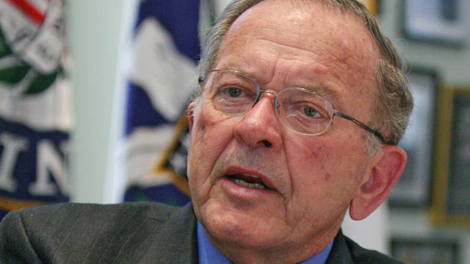DILLINGHAM, Alaska - A float plane carrying former Sen. Ted Stevens crashed into a remote mountain in Alaska, killing the revered former senator and four others and stranding survivors on a rainy, brush-covered hillside for more than 12 hours, authorities said Tuesday.
Former NASA chief Sean O'Keefe and his teenage son survived the Monday crash with broken bones and other injuries, said former NASA spokesman Glenn Mahone. The O'Keefes spent the night on the mountain with volunteers who discovered the wreckage and tended to the injured until rescuers arrived Tuesday morning.
Stevens and O'Keefe were longtime fishing buddies who had been planning a trip near where the amphibious plane crashed.
Alaska State Troopers identified the victims as Stevens; pilot Theron Terry Smith, 62, of Eagle River; William Bill Phillips, Sr., no age or hometown given; Dana Tindall, 48, of Anchorage; and Corey Tindall, 16, of Anchorage.
Four survivors were taken to Providence Hospital in Anchorage with varying degrees of injuries. They include O'Keefe and his teenage son. The other survivors are William Willy Phillips, Jr., 13, no hometown given; and Jim Morhard, of Alexandria, Va.
The crash was a stunning event in a state where Stevens became the most beloved political figure in Alaska history during his 40 years in the Senate, earning a reputation as a tireless advocate for projects that brought billions of federal dollars to the state. He was 86.
Last night, Alaska lost a hero and I lost a dear friend, Alaska Sen. Lisa Murkowski said in a statement. His entire life was dedicated to public service from his days as a pilot in World War II to his four decades of service in the United States Senate. He truly was the greatest of the Greatest Generation.
The plane crashed into a brush- and rock-covered mountainside sometime Monday night, authorities said. Volunteer pilots were dispatched to the area around 7 p.m. local time after the plane was found to be overdue at its destination, and they came upon the wreckage about a half hour later.
The weather soon took a turn for the worse, with heavy fog, clouds and rain blanketing the area and making it impossible for rescuers to arrive until after daybreak Tuesday. O'Keefe, his son, and two others were flown to the hospital.
The bodies of Stevens and the other four victims remained at the scene Tuesday, investigators said at a briefing in Juneau. Temperatures ranged from about 48 degrees to 50 degrees overnight at Dillingham.
Alaska National Guard spokesman Maj. Guy Hayes offered no details about the conditions of the survivors or their identities.
National Transportation Safety Board spokesman Ted Lopatkiewicz said the agency is sending a team to the crash site outside Dillingham, located in Bristol Bay about 325 miles southwest of Anchorage.
The cause of the crash was not immediately known, but the flights at Dillingham are often perilous through the mountains, even in good weather. Fergus said the plane was flying by visual flight rules, and was not required to file a flight plan.
National Weather Service data shows that weather conditions deteriorated between 1 p.m. and 2 p.m. Monday -- the approximate time the FAA said the plane took off. Visibility at Dillingham, the nearest observation area, was about 10 miles with overcast skies at 1:49 p.m.; it was 3 miles by 2:22, with light rain, fog and mist reported.
The aircraft is a 1957 DeHavilland DHC-3T registered to Anchorage-based General Communications Inc., a phone, Internet and cable company.
Federal Aviation Administration spokesman Mike Fergus said the plane took off at 2 p.m. Monday from a GCI corporate site on Lake Nerka, heading to the Agulowak Lodge on Lake Aleknagik.
The lodge is made of logs and sits on a lake, and photos show a stately main lodge room with a large imposing stone fireplace, a leather sofa and a mounted caribou head on the wall.
In a similar accident by another plane owned by GCI, an amphibious, float-equipped Havilland plane flipped after landing on Lake Nerka in 2002. The pilot drowned and a passenger was injured. The plane was landing on the lake in front of the lodge when the accident occurred.
Stevens was appointed to the Senate in 1968 and served longer than any other Republican in history. He was revered as a relentless advocate for Alaska's economic interests.
Stevens was one of two survivors in a 1978 plane crash at Anchorage International Airport that killed his wife, Ann, and several others. He remarried several years after the crash -- he and his second wife, Catherine, have a daughter, Lily.
The airport in Anchorage is now named after Stevens.
A decorated World War II veteran, Sen. Ted Stevens devoted his career to serving the people of Alaska and fighting for our men and women in uniform, President Barack Obama said in a statement. Michelle and I extend our condolences to the entire Stevens family and to the families of those who perished alongside Sen. Stevens in this terrible accident.
Over the years, Stevens directed billions of dollars to Alaska.
But one of his projects -- infamously known as the Bridge to Nowhere -- became a symbol of pork-barrel spending in Congress and a target of taxpayer groups who challenged an appropriation for hundreds of millions of dollars for bridge construction in Ketchikan.
Stevens' standing in Alaska was toppled by corruption allegations and a federal trial in 2008. He was convicted of all seven counts -- and narrowly lost his Senate seat to Democrat Mark Begich in the election the following week.
But five months after the election, Attorney General Eric Holder sought to dismiss the indictment against Stevens and not proceed with a new trial because of prosecutorial misconduct by federal prosecutors.
Plane crashes in Alaska are somewhat common because of the treacherous weather and mountainous terrain. Many parts of the state are not accessible by roads, forcing people to travel by air to reach their destinations.
Begich's father, Nick Begich, who was Alaska's only congressman in 1972, was killed when his plane disappeared over Alaska with then-House Majority Leader Hale Boggs of Louisiana.
The Stevens crash is the latest in a long line of aviation accidents to claim political figures over the years in the U.S., including Pennsylvania Sen. John Heinz in 1991, South Dakota Gov. George Mickelson in 1993, Missouri Gov. Mel Carnahan in 2000 and Minnesota Sen. Paul Wellstone in 2002.
O'Keefe, 54, served as secretary of the Navy and as a top aide to Dick Cheney when he was Defense Secretary before being appointed NASA administrator for three tumultuous years. He was deputy director of the Office of Management and Budget when President George W. Bush asked him in late 2001 to head NASA and help bring soaring space station costs under control.
But budget-cutting became secondary when the shuttle Columbia broke apart during re-entry in 2003.
O'Keefe's most controversial action at NASA was when he decided to cancel one last repair mission by astronauts to the Hubble Space Telescope. He said the mission was too risky. His successor overturned the decision. The Hubble mission was carried out last year.
O'Keefe left NASA in 2005 to become chancellor of Louisiana State University. He is now the CEO of defense contractor EADS North America and oversees the bid for the hotly contested Air Force refueling jet contract.
The contract competition, which pits EADS against rival plane maker Boeing Co., is for a piece of what could eventually be $100 billion worth of work replacing the military's fleet of aging tankers.
EADS North America confirmed in a statement with a great sense of relief that O'Keefe and his son survived the crash.


